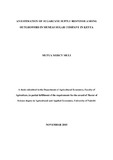| dc.description.abstract | Over the past few decades, Kenya has had a structural deficit in sugar despite the great potential the country has in sugarcane production. Kenya‟s sugar industry relies entirely on sugarcane production. Sugarcane production presents an opportunity for income generation and poverty alleviation to small scale sugarcane farmers in the cane growing areas. While the country has good agro-climatic conditions for sugarcane production, the question as to why the milling companies face shortages in sugarcane supply and often operate below their installed capacity and resort to cane poaching remains unanswered. The objective of this study was to assess the responsiveness of farmers supplying sugarcane to Mumias Sugar Company to changes in the producer environment. The study used time series data collected from the annual publications by the Kenya Sugar Board and the Ministry of Agriculture. A Vector Error Correction Model (VECM) was used to estimate the responsiveness of sugarcane farmers to prices and other economic incentives for the period 1980 to 2013.
The unit root tests showed that all the variables were integrated of order one i.e, I(1). The cointegration tests showed that the variables were co-integrated with one cointegrating equation. The presence of integration in the individual variables and cointegration among variables set the condition for the use of a Vector Error Correction Model in supply response analysis. The results showed that in the short-run, planned supply expressed in terms of land area allocated to sugarcane was positively affected by changes in its own price in the immediate preceding period. The responsiveness of the farmers to changes in own-price was however inelastic implying that manipulating the price of sugarcane may not yield much response in terms of land allocation in the short-run.
In the long-run, all variables (own price, maize price, yield, privatization dummy and time trend) in the model were found to significantly affect the area of land allocated to sugarcane
vi
by outgrowers. The own-price and yield elasticities were positive while the cross-price elasticity of sugarcane supply was negative as hypothesized. The coefficient of the dummy variable for privatization and time trend were also negative but significant. Sugarcane supply was however found to be inelastic to all variables in the model in the long-run. This implies that the sugarcane farmers might be facing a captive value chain whereby they are dependent on the Sugar company when making land allocation decisions.
With regard to the cross-price elasticity, the maize price elasticity of sugarcane supply was less than unity. While a price reduction strategy for the competing enterprise cannot be encouraged as it would be counter productive, policies that would improve the profitability of sugarcane relative to other enterprises are recommended in order to make it more attractive to the farmers in support of government‟s sugar self-sufficiency policy goal. Such policies may involve investing in yield-enhancing interventions such as making inputs accessible at more competitive prices and taking control of the unfavourable impacts of weather-related risks through irrigation as well as research and development of high-yielding sugarcane varieties with high sucrose content.
A dummy variable based on the change of milling company ownership and management from government to private ownership for Mumias outgrowers was significant but negative in the long-run with respect to the farmers‟ land allocation decisions. This implies that in order for the policy shift of privatization to achieve increased land allocation to sugarcane, it is necessary that other impediments to the farmers‟ supply response be addressed. Such impediments include mismanagement of the milling company and inefficiencies in processing payments to the farmers for cane delivered. It is recommended that a study similar to this one is done after some years when a longer time series on the privatization variable is available to ascertain whether the status remains.
vii
The long-run elasticity of supply estimates were found to be higher than the short-run estimates. This was expected because land is a fixed asset and its reallocation moves towards the desired level as factors that are fixed in the short-run become more variable in the long-run. Based on the findings of this study, it can be concluded that the sugarcane farmers supplying Mumias Sugar Company are facing a captive value chain. Their dependence on the company limits their responsiveness to changes in the producer environment such that while they respond as expected, all the elasticities are inelastic. It may be time to relax the self-sufficency policy goal in sugar and encourage farmers to grow what they consider profitable so as to put an end to the welfare losses emanating from the sub-sector. | en_US |



